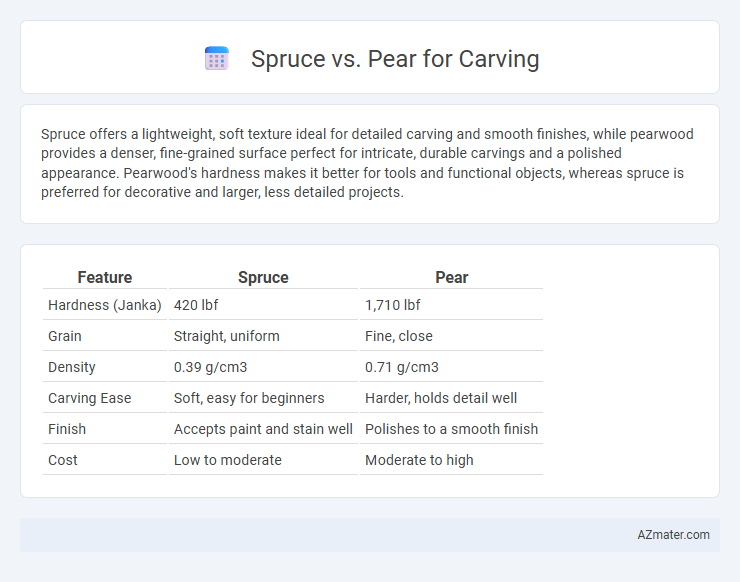Spruce offers a lightweight, soft texture ideal for detailed carving and smooth finishes, while pearwood provides a denser, fine-grained surface perfect for intricate, durable carvings and a polished appearance. Pearwood's hardness makes it better for tools and functional objects, whereas spruce is preferred for decorative and larger, less detailed projects.
Table of Comparison
| Feature | Spruce | Pear |
|---|---|---|
| Hardness (Janka) | 420 lbf | 1,710 lbf |
| Grain | Straight, uniform | Fine, close |
| Density | 0.39 g/cm3 | 0.71 g/cm3 |
| Carving Ease | Soft, easy for beginners | Harder, holds detail well |
| Finish | Accepts paint and stain well | Polishes to a smooth finish |
| Cost | Low to moderate | Moderate to high |
Introduction to Carving Woods: Spruce vs Pear
Spruce and pear are popular carving woods known for their distinct textures and workability. Spruce offers a soft, lightweight grain ideal for beginners and detailed relief carving, while pear wood provides a denser, fine-grained surface preferred for intricate, smooth finishes in advanced projects. Both woods vary in hardness and grain tightness, influencing tool control and the final appearance of sculptures or decorative items.
Botanical Characteristics of Spruce and Pear
Spruce trees, belonging to the genus Picea, are coniferous evergreens with needle-like leaves and stiff, woody cones, producing softwood valued for its straight grain and light weight, ideal for structural carving and musical instruments. Pear trees, from the genus Pyrus, are deciduous hardwoods characterized by smooth bark, broad leaves, and dense, fine-grained wood known for its uniform texture and excellent carving properties, commonly favored for detailed sculpture and fine woodworking. The botanical contrast between spruce's resinous, porous softwood and pear's tight-grained hardwood influences their carving applications, with spruce offering ease of shaping and pear providing durability and fine detail retention.
Grain Structure Comparison: Spruce and Pear
Spruce features a straight, even grain with a fine texture, making it ideal for detailed carving and providing good strength with minimal splitting risk. Pear wood displays a fine, close grain with a slightly denser and harder structure, allowing for smooth, intricate carvings and a polished finish. Both woods offer excellent workability, but spruce's lighter weight contrasts with pear's heavier, more durable composition.
Workability of Spruce for Carving
Spruce offers excellent workability for carving due to its lightweight, fine, and straight grain that allows for smooth, detailed cuts with minimal effort. Its softness relative to harder woods like pear makes it more forgiving for knife and chisel work, reducing blade wear and enabling precise shaping. Spruce's consistent texture supports both rough shaping and intricate detailing, making it a favored choice for woodcarvers seeking ease and control.
Workability of Pear for Carving
Pear wood is highly valued for carving due to its fine, even texture and smooth grain, which allow for precise detailing and clean cuts. Its medium density provides a balanced hardness that is neither too soft nor too brittle, making it easy to shape while maintaining durability. Compared to spruce, pear wood offers better workability for intricate designs and a more refined finish, preferred by many artisans for detailed wood carving projects.
Durability and Longevity in Finished Carvings
Spruce offers a lightweight, softer texture that carves easily but may be less durable and prone to dents in finished carvings, making it ideal for delicate designs rather than long-lasting pieces. Pear wood, known for its fine grain and medium hardness, provides greater durability and longevity, maintaining its shape and detail over time even with regular handling. Carvings crafted from pear wood typically exhibit superior resistance to wear and aging, ensuring a lasting aesthetic appeal in intricate or functional artwork.
Surface Texture and Finishing Differences
Spruce features a fine, straight grain with a consistent surface texture that allows for smooth carving and detailed finishes, making it ideal for intricate designs. Pear wood presents a denser, tighter grain with a slightly oily texture that provides a silkier finish but requires more effort in sanding and smoothing. While spruce offers easier shaping and a matte surface, pear delivers a polished, lustrous finish preferred for refined decorative carvings.
Suitability for Fine Detail and Intricate Designs
Spruce offers a softer grain ideal for fine detail and intricate designs, allowing carvers to achieve smooth, precise cuts with minimal effort. Pear wood, while denser and slightly harder, provides excellent control for detailed work, resulting in sharp, defined edges resistant to wear. Both woods suit delicate carving, but spruce's lightweight nature makes it preferable for extended projects requiring extreme finesse.
Cost and Availability: Spruce vs Pear
Spruce wood is generally more affordable and widely available in lumber markets, making it a cost-effective choice for carvers on a budget. Pear wood tends to be pricier due to its slower growth and limited regional availability, often imported for specialized woodworking purposes. Both woods offer distinct carving qualities, but cost and accessibility favor spruce for larger projects and beginners.
Best Applications: Choosing Between Spruce and Pear for Your Project
Spruce wood, known for its lightweight and soft texture, is ideal for detailed carving projects like musical instruments and intricate sculptures, providing ease of shaping and fine detailing. Pear wood, with its fine grain and hardness, excels in furniture carving and decorative items that require a smooth finish and durability. Selecting between spruce and pear depends on the project's demand for softness versus density, influencing the ease of carving and the final aesthetic quality.

Infographic: Spruce vs Pear for Carving
 azmater.com
azmater.com